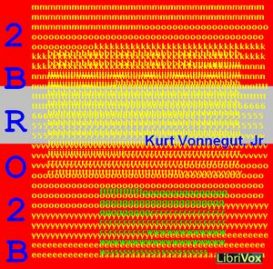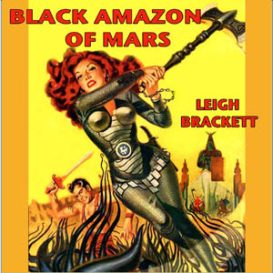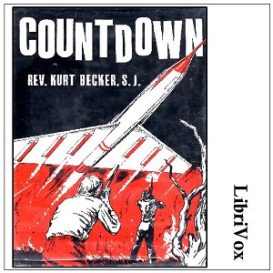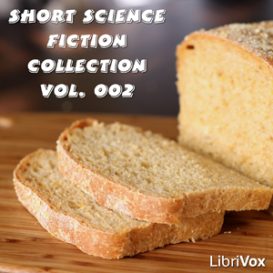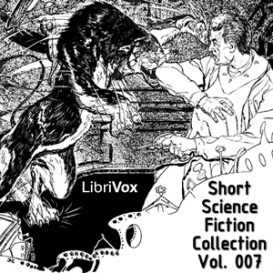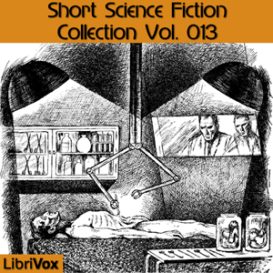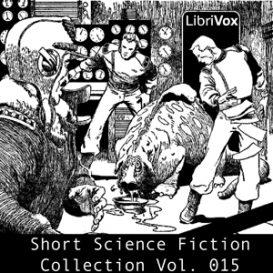Science Fiction
Showing 1–50 of 120 results
2 B R 0 2 B (Dramatic Reading)
Kurt Vonnegut, Jr. was a prolific and genre-bending American novelist known for works blending satire, black comedy, and science fiction, such as Slaughterhouse-Five, Cat’s Cradle, and Breakfast of Champions. 2 B R 0 2 B is a satiric short story that imagines life (and death) in a future world where aging has been “cured” and population control is mandated and administered by the government. (Summary by Wikipedia and Laurie Anne Walden) This recording is done as a dramatic reading. Characters: Narrator: Denny Sayers Hospital Orderly: Mark F. Smith Painter: Alan Davis-Drake Leora Duncan: Laurie Anne Walden Dr. Hitz: Michael Yard Wehling: Julian Jamison Federal Bureau of Termination hostess: Kara Shallenberg
20 Short Science Fiction Stories
Compilation of 20 Science Fiction Short Stories – Summary by Kirk Ziegler
3 Science Fiction Stories
These are three imaginative SF stories by an author I admire a lot, William Tenn. Venus is a Man’s World, (Galaxy Science Fiction, July 1951), Project Hush (Galaxy Science Fiction, 1954_ and Of All Possible Worlds. (Galaxy, Sept 1956) – Summary by phil chenevert
3 Science Fiction Stories by Frank Herbert
As the title indicates, here are three SF stories by Frank Herbert, Missing LInk, originaly purlished in Astounding SF, 1959; Operation Haystack, also published in Astounding SF 1959; and Old Rambling House, published in Galaxy SF 1958. – Summary by Phil chenevert
3 Science Fiction Stories by Gerald Vance
Three Science Fiction stories by the great Gerald Vance: Monsoons of Death is a very nice blend of horror story and a study of true bravery on the planet Mars. A newly commissioned lieutenant finds out a lot about both! In Larson’s Luck, Vance takes us on a lighthearted jaunt into hot shot space ship pilots, piracy and the good part of breaking the rules. The last story, Vital Ingredient, takes the listener far into the future when the sport of boxing still has two muscled opponents battling it out in a ring, but they are simply puppets, every muscle, feint and jab controlled by ring side ‘managers’; ex fighters who have moved up. The story asks the question: is this how champions are made? and answers it of course in a most satisfying manner. Summary by Phil chenevert
3 Science Fiction Stories by Lester del Ray
The quirky mind of famous SF writer Lester del Ray gives us three wonderful tales ranging from zombies (Dead Ringer), time travel (how do you convince your earlier self it is safe to get into the time machine, eh?)(…And It Comes Out Here) and eternal life (The Dwindling Years). Listen and enjoy.
3 SF Stories by Jack Williamson
Three classic SF stories by Jack Williamson: The Cosmic Express, The Pygmy Planet and Salvage in Space. All were published in Astounding Stories in the very early 1930’s. and all are fine examples of the far ranging imagination of science fiction writers of the day. – Summary by Phil Chenevert
3 Weird SF Stories by Fritz Leiber
These are three of the strangest stories I could find by the very talented Fritz Leiber. And by strange I mean odd, weird, kinda creepy and yet wonderful. Not your normal Science Fiction here but then Leiber had an amazing imagination and these certainly made me stretch mine. – Summary by phil chenevert
4 SF stories by C. M. Kornbluth
Four nifty Science Fiction stories by the great C. M. Kornbluth. The Adventurer – The Altar at Midnight – With These Hands and The Marching Morons. All were first published in the 1950s – Summary by philc
4 SF Stories by Mack Reynolds
4 Science Fiction Stories by the quirky Mack Reynolds from the golden age of SF, the 1950s – Summary by phil chenevert
5 Science Fiction Stories by Mack Reynolds
Five early stories by one of my favorite SF writers, Mack Reynolds. Medal of Honor is an intriguing look into the mind of someone who is above the law; who cannot commit a crime. How will he act? especially if he is a self centered drunk? Potential Enemy is story about the sad state of human minds that are ruled by fear and paranoia. Happy Ending is an SF story about the far future when the last solar system wide dictator has been finally defeated and what will he do? What will he do? This is also an exploration of mental megalomania and it’s effects. His happy ending is perhaps suitable, but probably not so happy. A Gun For Hire explores in a light-hearted but painful way, the fact that hired guns are just that: hired. The final story is the funniest of the lot the and is set in Tangiers in the present or very near future. UFO’s are a crackpot idea, right? Well, perhaps not. – Summary by Phil Chenevert
5 SF stories by Mack Reynolds
Five Science Fiction stories from the strange mind of Mack Reynolds. Always innovative and interesting, these were published in the early science fiction and fantasy magazines of the 1940’s and 50’s. – Summary by phil chenevert
A Crystal Age
A Crystal Age is a utopian novel written by W. H. Hudson, first published in 1887. The book has been called a “significant S-F milestone” and has been noted for its anticipation of the “modern ecological mysticism” that would evolve a century later. (Summary by Wikipedia)
Adaptation
In 1960 when this was published, the Cold War was at its height. Communism and Free Enterprise (Democracy) were locked in a ferocious struggle to prove that their political ideology was the best form of government for human kind. No holds were barred in this fight; propaganda was poured forth by both sides in a constant push to be seen as better, more progressive, more productive. Nuclear war was a constant threat. I know, I lived through that time. Thankfully the world came through that stressful time without a hot war but the question was not really settled: which is the better system? This story explores that question. “Hardly had man solved his basic problems on the planet of his origin than he began to fumble into space. Barely a century had elapsed in the exploration of the Solar System than he began to grope for the stars. And suddenly, with an all but religious zeal, mankind conceived its fantasy dream of populating the galaxy.” summary by Phil chenevert and the author
After London, or Wild England
Jefferies’ novel can be seen as an early example of “post-apocalyptic fiction.” After some sudden and unspecified catastrophe has depopulated England, the countryside reverts to nature, and the few survivors to a quasi-medieval way of life. The first part of the book, “The Relapse into Barbarism”, is the account by some later historian of the fall of civilisation and its consequences, with a loving description of nature reclaiming England. The second part, “Wild England”, is an adventure set many years later in the wild landscape and society. The book is not without its flaws (notably the abrupt and unsatisfying ending) but is redeemed by the quality of the writing, particularly the unnervingly prophetic descriptions of the post-apocalyptic city and countryside. (Summary by Ruth Golding and Wikipedia)
An Anglo-American Alliance: A Serio-Comic Romance and Forecast of the Future
Described by io9 as ?the first lesbian science fiction novel,? An Anglo-American Alliance is a quasi-farcical tale of love, transformation, and geopolitics set in the far-flung futuristic year of 1960. In it, the titular Anglo-American Alliance has established itself as the world government, ushering in new age of technological and social revolution. However, even in this halcyon period, the ?love that dare not speak its name? remains an anathema. The novel?s central narrative follows the long-burgeoning but secret romance between two women at a ladies? seminary school in Cornwall: Margaret MacDonald and Aurora Cunningham. Throughout this tale, we follow their trials and tribulations as they grapple with secret longings and learn how to harness the powers of science and technology to make their dreams come true. Note: Despite its fairly progressive views on sexuality and gender identity, this novel is nevertheless a byproduct of the period in which it was written. It contains unfortunate moments of ethnocentrism, antisemitism, and casual racism that might offend certain listeners. – Summary by ChuckW
Black Amazon of Mars
Carrying out the last wishes of a comrade, mercenary Eric John Stark takes on the task of returning a stolen talisman to a walled city near the Martian pole; a city that guards the mysterious Gates of Death. Now all he has to do is get past the brutal clans of Mekh and the shadowy Lord Ciaran to get to Kushat where they?ll probably attempt to kill him. All while he tries to hold on to a talisman that imprints ancient memories of the Gates in his mind. That?s not easy for a human raised by Mercurian aborigines. – Black Amazon of Mars is the third story to feature Brackett?s hero Eric John Stark, and was later expanded into the novel People of the Talisman. It was first published in Planet Stories magazine in March of 1951. (Summary by Gregg Margarite)
Black Amazon of Mars (Version 3)
In his final adventure on Mars, Eric John Stark acquires a relic of an ancient Martian hero, a gem or lens which is believed to be the key to the strength of Kushat, the city that guards the Gates of Death in the frozen north. A brief inspection of the artifact plunges Stark into the mind of its creator, where he sees, through those long-dead eyes, the unutterably ancient, beautiful, and evil Martian race who are imprisoned in the ice beyond the Gates of Death, alive and plotting to reclaim Mars for themselves and to extend the ice, their world, around the whole planet. Falling into the hands of roving outlaws, Stark survives torture and overcomes his cruel torturer, thereby winning the respect of the leader, who wears black clothing and a fearful mask. After a daring escape, Stark makes his way to Kushat, with the double intent of restoring the artifact and warning the city that the outlaw band intends to attack it. He finds both tasks difficult but at length succeeds in persuading the city officials of the danger. The battle which ensues costs both sides dearly, and it also precipitates the main action of the novel, for a citizen flees the falling city intent upon opening the Gates of Death in the hope that whatever lies beyond will overwhelm the invaders. Stark pursues him, still carrying the ancient amulet, and is himself pursued by the now unmasked, black-clad leader of the outlaw band. Finally three antagonists find themselves bound together in a struggle with the ancients for possession of the planet Mars. (This story was later expanded in book form under the title People of the Talisman 1964.) – Summary by T. A. Copeland
Conquest Over Time
Pat Travis, a spacer renowned for his luck, is suddenly quite out of it. His job is to beat his competitors to sign newly-Contacted human races to commercial contracts… But what can he do when he finds he’s on a planet that consults astrology for literally every major decision – and he has arrived on one of the worst-aspected days in history? Michael Shaara, later to write the Pulitzer-winning novel “The Killer Angels”, wrote this story for Fantastic Universe in 1956. (Summary by Mark F. Smith)
Contagion
Minos was such a lovely planet. Not a thing seemed wrong with it. Excepting the food, perhaps. And a disease that wasn’t really. Originally published in Galaxy Science Fiction, October, 1950. Katherine Anne MacLean (born January 22, 1925) is an American science fiction author best known for her short fiction of the 1950s which examined the impact of technological advances on individuals and society. – Summary by Wikipedia, story heading, and david wales
Cosmic Castaway
“Within a year Earth would be a vassal world, with the Sirian invaders triumphant. Only Standish, Earth’s Defense Engineer, could halt that last victorious onslaught?and he was helpless, the lone survivor of a prison ship wrecked in uncharted space.” – Summary by publishers blurb
Countdown
The first flight to outer space became an actual fact ? Mars would be the first stop. But before the spaceship took off, two insane enemies almost succeeded in preventing the departure. This science fiction story for teens was written by a Catholic priest. (Summary from the original jacket and Maria Therese)
Crypt-City of the Deathless One
Only one man ever returned from Black Forest of Ganymede– and it ruined him. Now two adventurers with questionable motives have hired Ed Garth to lead them back to the legendary crypt-city within, where he will be forced to confront crimes and sacrifices he can no longer remember. – Summary by EVKesserich
Crystal Crypt, the & Beyond the Door
Two early science fiction stories by the wonderful craftsman, Philip K. Dick. In the Crystal Crypt, taken from the 1954 Planet Stories, the war between Mars and Terra is about to erupt and earth has only merchants and salesmen to fight; can they carry out their mission? Beyond the Door is a story that asks and answers the question: what lives beyond the door? And is it dangerous? (Summary by Phil Chenevert)
Cubs of the Wolf
The Markovian Nucleus was once an existential threat to the council worlds, but then, in the space of only 70-80 years, their culture completely changed. They became model galactic citizens and everyone was too relieved to question their good fortune. Now, Doctoral Candidate Cameron Wilder and his new bride, Joyce Wilder, are on the case. What actually happened to the Markovians? – Summary by Katzsteinz
Facing the Flag
Like The Begum’s Millions, which Verne published in 1879, it has the theme of France and the entire world threatened by a super-weapon (what would now be called a weapon of mass destruction) with the threat finally overcome through the force of French patriotism. (Summary by Wikipedia)
Short Science Fiction Collection 002
Science fiction (abbreviated SF or sci-fi with varying punctuation and case) is a broad genre of fiction that often involves sociological and technical speculations based on current or future science or technology. This is the second volume of reader-selected collection of short stories originally published between 1941 and 1963, that entered the US public domain when their copyright was not renewed. (Introduction by Cori Samuel with input from Wikipedia.) Note: This collection originally included a tenth story, The Burning Bridge by Poul Anderson. That recording was removed in November 2011 because of a copyright claim.
Short Science Fiction Collection 013
Science fiction (abbreviated SF or sci-fi with varying punctuation and case) is a broad genre of fiction that often involves sociological and technical speculations based on current or future science or technology. This is a reader-selected collection of short stories that entered the US public domain when their copyright was not renewed. Summary by Cori Samuel, with Wikipedia input.
Short Science Fiction Collection 014
Science fiction (abbreviated SF or sci-fi with varying punctuation and case) is a broad genre of fiction that often involves sociological and technical speculations based on current or future science or technology. This is a reader-selected collection of short stories that entered the US public domain when their copyright was not renewed. Summary by Cori Samuel, with Wikipedia input.
Short Science Fiction Collection 015
Science fiction (abbreviated SF or sci-fi with varying punctuation and case) is a broad genre of fiction that often involves sociological and technical speculations based on current or future science or technology. This is a reader-selected collection of short stories that entered the US public domain when their copyright was not renewed. Summary by Cori Samuel, with Wikipedia input.


